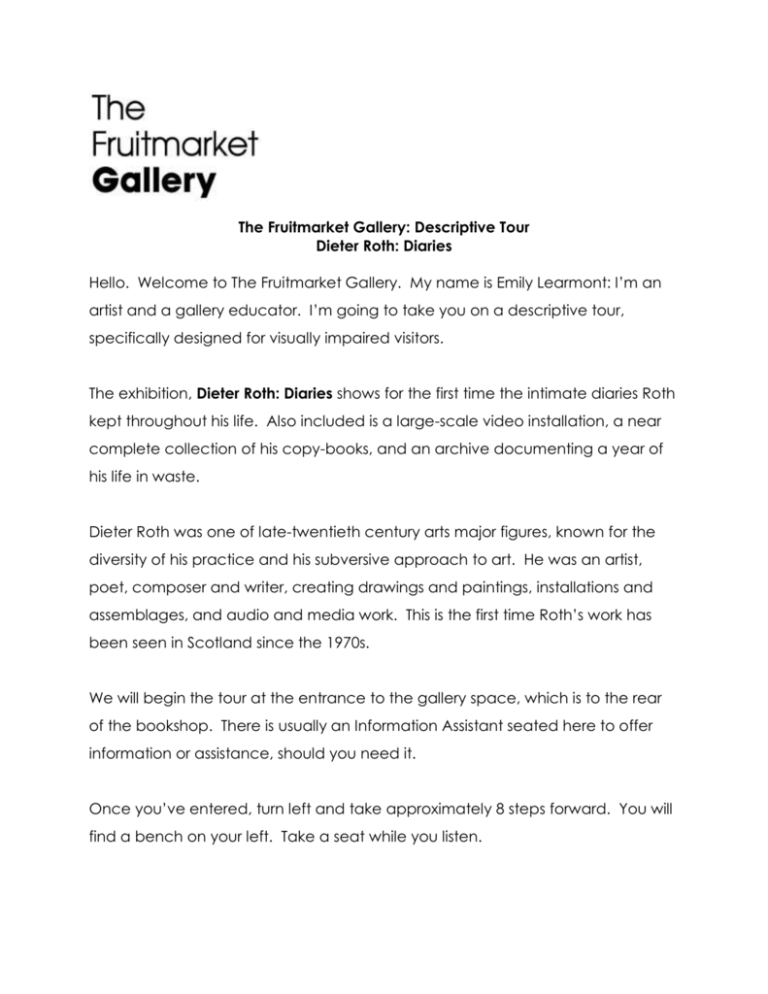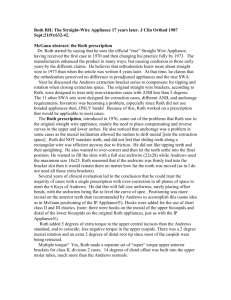Read a written description of the tour
advertisement

The Fruitmarket Gallery: Descriptive Tour Dieter Roth: Diaries Hello. Welcome to The Fruitmarket Gallery. My name is Emily Learmont: I’m an artist and a gallery educator. I’m going to take you on a descriptive tour, specifically designed for visually impaired visitors. The exhibition, Dieter Roth: Diaries shows for the first time the intimate diaries Roth kept throughout his life. Also included is a large-scale video installation, a near complete collection of his copy-books, and an archive documenting a year of his life in waste. Dieter Roth was one of late-twentieth century arts major figures, known for the diversity of his practice and his subversive approach to art. He was an artist, poet, composer and writer, creating drawings and paintings, installations and assemblages, and audio and media work. This is the first time Roth’s work has been seen in Scotland since the 1970s. We will begin the tour at the entrance to the gallery space, which is to the rear of the bookshop. There is usually an Information Assistant seated here to offer information or assistance, should you need it. Once you’ve entered, turn left and take approximately 8 steps forward. You will find a bench on your left. Take a seat while you listen. Pause your audio-player here, and press play when you are ready. Remember, you can pause at any time during the tour. You are now in a darkened gallery space. You may be aware of lots of flickering lights. These come from the screens of 128 television sets. They are placed on three large-scale shelving units, positioned diagonally and running almost the entire length of the floor. The units are made of pinewood and are functional in style. The outer two units are 290 cm high by 420 cm wide. The middle unit is taller: it is 340 cm high by 420 cm wide. Each unit is divided into four sections, containing five or six shelves. There are two television sets on each shelf. They are 36 cm square and have black surrounds. The units are stabilised by wooden struts. If you come closer, take care not to trip on these. The installation is called Solo Scenes. It is a video diary, recording the year from 1997 to 1998, which turned out to be the last of Roth’s life. Roth set up cameras in different rooms in his homes and studios in Germany, Iceland and Switzerland, and allowed the film to run while he went about his daily life. Each of the 128 television sets plays different footage, and is carefully labelled with the date and place where it was shot. The television screens offer us a glimpse into Roth’s world. We see his kitchens with their cooking utensils, food packaging and pot plants; and his studios with their specially-devised storage units, electrical wiring systems, and desktops spread with notebooks and pots of pens. Roth lets the cameras document the minutiae of his domestic life: his empty coco-cola bottles, tubes of toothpaste and hole-punch. From time to time, Roth wanders past. He is an elderly figure with spectacles and a white beard. He dresses comfortably in open-necked shirts, trousers held up with braces, and knitted cardigans. Sometimes we see him engaged in activities such as drawing vigorously, doing the washing up or tidying his studio. But more often he is stationary, reading by lamplight, listening to music or dozing at his desk. There are intimate moments, too. Roth films himself asleep in bed, and sitting reading on the toilet. We observe him in his underwear, his dressing gown and momentarily naked. He behaves completely unselfconsciously, as if unaware of our presence. At these times, we may feel shy of our own sense of curiosity; and uncomfortable with the impartiality of the camera’s lens. Although Roth’s locations are set in different countries – reflecting his international career – the interiors of his rooms look remarkably similar, when cropped by the cameras’ viewfinders. Often it is difficult to tell whether the rooms are for living or working in. They are designed in a functional way, rather than following fashionable tastes. Kitchens have tables for drawing and writing at; studios have beds and eating areas; bathrooms are for reading books. This demonstrates the way Roth’s life and art continuously blend as one. You may be able to hear sounds accompanying the images: clattering dishes, coughing fits, muttered telephone conversations, strains of music, creaking furniture, and the rustle of linen as Roth tosses in bed. When Roth films himself at night, the room is dark except for perhaps a beam of light from an angle-poise lamp. When the film comes to an end, the screen goes blue before restarting. The 128 television sets replaying Roth’s life create a mesmerising effect. On one hand, we may feel that we are getting to know Roth; on the other, we may feel alienated and alone. Although we can scrutinise his face at close-range, we still have no idea what he is actually thinking. Solo Scenes was always intended to be seen in public. It combines introspection with self-promotion, and predictability with daring. Made using one of the late twentieth century’s most popular means of visual communication, it explores the time-honoured subject of the artist in old age. Now pause your audio-player. Press play when you are ready to move on. Stand up and turn 45 degrees to your right. Walk approximately 23 steps diagonally across the gallery, towards a doorway in the far wall. Beware of two pillars that you will pass on your left and right. As you walk alongside the shelving units, you may want to take a closer look at the television screens. Be careful not to trip on the struts that jut out. When you reach the doorway, step inside. Pause your audio-player here. You are in another, smaller gallery. The light levels are normal now. If you take approximately seven steps forward, you will come to a grey unit with a Perspex top. You are now in front of Dieter Roth’s diaries. There are 46 of them, covering the years from 1965 to 1998. They are arranged in chronological order, in four rows. The earliest diaries are smallest; they are on the top row. Over the years, they increase in size and become thicker, especially the most recent ones in the front row. They are all just ordinary, everyday diaries, available from any stationery shop. The diaries are red, tan, brown, dark green, dark blue and black. One of the diaries in the front row, fifth from the right is a bit different: it is white with gold flecks. Some of the diaries have imitation leather covers. Others are school exercise books. Most have the year stamped on them. A few have the Icelandic word for diary, dagbok. Each is well-thumbed, stained and torn. Several have broken spines, repaired with white bookbinders’ gauze. Some have yellow post-it notes stuck to them. These correspond to Roth’s complex cataloguing system, and relate to his copybooks upstairs. 8 of the diaries are open, so we can look inside. They are all made of different types of paper: headed, blank, lined or squared. Roth’s handwriting is distinctive: there are lines of slanted italics, block capital letters and hasty scrawls. They are written with a fine black nib, and decorated with colour felt pens. The pages are embellished with scribbles and doodles; crossings-out, highlights and underscores. In some of the diaries he plays around, writing upside down and around the edge of the page; although these are not displayed here. The diary on the top row, third from the left must have once got wet. Its ink has run and turned into washes of bright pink paint. The diaries are written in German, Icelandic and English. They are crammed full of appointments, addresses and reminders of things to do. Often he notes his travel plans and locations: Hamburg, Vienna, Amsterdam or Reykjavik. He makes sketches and diagrams, and invents silly limericks and poems, all displaying his brilliantly creative mind. He also incorporates memorabilia, such as family snapshots, tickets, menus and bills. At times, Roth’s diaries take on the role of intimate journals. There are passages of deep self-analysis, where Roth confides his feelings of frustration, inadequacy and shame. In an interview, he commented, ‘I believe the diaries are primarily an attempt to register a complaint, a shrill howl of complaint … People [Will] bawl and cry when they read it. For me, it’s about empathy, about lament.’ At one stage, Roth tried to impose a system on his diary-keeping. He decided to use three: one for recording appointments, another for commenting on them, and a third for their further analysis. But he found the discipline impossible to keep up. In fact, it bored and depressed him. Roth wrote autobiographically from a young age. He was born in Hannover in Germany in 1930; his mother was German and his father was Swiss. From 1939, he spent each summer in Switzerland, and moved there permanently in 1943, sponsored by a charity protecting Swiss children in Germany from the war. He stayed in Zurich with a family who also shared their home with Jewish and communist actors and artists. Roth wrote home several times a week. Although he often described his feelings of homesickness, he realised that he had found a way to express himself, and this excited him. Encouraged by the other residents, he began to paint and write poetry. He was finally reunited with his family in 1946 when they settled in Switzerland. Throughout his life, Roth kept a diary. He even had large pockets sewn onto his jackets so he could carry them around. He enjoyed discussing them and showing them to friends. By continually cross-referencing and annotating them, he was provided with a constant supply of source material for his large-scale work. The Fruitmarket Gallery is pleased to present Roth’s diaries to the public for the first time. In their present state, they are fragile and unexplored. Whether they should be treated as archival material or works of art is unclear. But they offer an insight into Roth’s output, its origins and its legacy. Pause your audio-player here. Turn around and walk approximately 22 steps through the doorway and the main gallery space, keeping to your left. Take care to avoid a pillar, which will be in your way. Stop when you reach the gallery entrance, where the tour began. If you would like any information or assistance, please ask the Information Assistant seated here. Now pause your audio player. The tour will continue on the gallery’s upper level. You can either walk up a staircase, or take a lift. For the staircase, turn left. You will find a hand rail on either side. There are thirteen steps, followed by a small landing, and then a further eleven steps. When you reach the top, turn left into the gallery space. There is usually an Information Assistant seated here. For the lift, walk approximately 22 steps diagonally through the bookshop, towards the front door. Take care to avoid the bottom step of the staircase, book displays, and the corner of the reception desk. The lift is to the left of the front door. If you are taking the lift, pause your audio player here. However, if you are taking the staircase, just keep listening – these instructions won’t take long. To call the lift, press the button to the right of the door. When the doors open, step inside and press the button on the top right to go up. Turn around. As the lift ascends, you will hear voices singing up and down the scale. This is a sound installation by the artist, Martin Creed. It is called Work No 409. When you arrive, step outside. Pause your audio player here. Now you are on the upper level, follow the wall around to your right for approximately 11 steps. The walkway is narrow here, and the top of the staircase juts out to your left; so take care. When you’ve passed the top of the staircase, you will be in the gallery space. There is usually a gallery attendant seated here. Now pause your audio player. The tour resumes here. You are now in a large, open-plan gallery. The rows of skylights that run the length of the roof have been blocked out, so the light levels are low. There are six pillars, part of the building’s original structure, so be careful to avoid these. Turn 45 degrees to your left and walk approximately 8 steps forward, towards the long wall. Now turn 135 degrees to your right. Or, if you prefer to imagine a clock face, turn to four o’clock. You should be facing a plywood shelving unit. It is 155 cm wide by 174 cm high. It has four shelves, holding roughly 19 ring-binder files each. Most of the files are black and grey; but some are more colourful: they are yellow, blue and green. Each file is labelled with a date and location. The labels are all different: some are written in block capital letters, while others are scrawled. Several files have white numbers painted on them to assist Roth with cross-referencing. The files are filled with plastic sleeves, containing material supplementing the diaries. Roth stored newspaper and magazine cuttings, Polaroid photos of friends, instruction manuals and text books, and packaging, letters and notes. He then used these to make what he called his ‘copy-books.’ Pause your audio-player here. Now turn 135 degrees to your left, or from 4 o’clock back to 12 o’clock. Walk 4 steps towards the long wall, where you will find a grey shelf with a Perspex lid. You are now in front of a collection of Roth’s copy-books. They are mostly A4 format, with grey board covers and white bookbinders’ gauze reinforcing their spines. Roth has written their titles on them in thick black pen. Some of the copy-books are stacked, some are shelved end-on and some are open. Roth used the material he collected in the ring-binder files to incorporate into books. He then gave these to his publisher, Jan Voss of Boekie Woekie in Amsterdam to be produced in limited editions, usually of no more than ten. Roth sold these to fund other projects, or gave them to friends. His best-known copybook is called ‘A Diary,’ which was used as the catalogue for his exhibition at the Venice Biennale in 1982. Turn right and walk three steps ahead. Then turn left. You are now at one end of the shelf. The first item displayed on the shelf is an open ring-binder file. It shows some family photos, dated 15th August 1978. They are slightly out-of-focus and printed in brown and white. Roth has added drawings and scribbled captions underneath. To the left is its copy-book version. The material in the ring-binder file has been colour photocopied and hand-bound into a book. In some ways, the copy- book is more visually satisfying than its original. The images are more tonal and distinct. Work your way along the shelf, moving to your left. You will pass some red and green files, filled with squashed milk cartons; rows of copy-books based on guest books and technical manuals; a series of diagrammatic drawings; a largeformat copy-book open at a photo of Roth’s suitcase which is stuffed with luggage; some music manuscript; and a hard-bound catalogue for one of Roth’s exhibitions in Vienna. Roth made nearly 100 copy-books, all numbered according to his own categorisation. They demonstrate the discipline he applied to developing his creative process. The copy-book collection here is almost complete, and will be added to during the course of the exhibition. In his own words: ‘Books should thereby i.e in this context mean a thing layered in groups i.e. a community of like-minded things pasted or sewed together standing about or about standing i.e. standing or sandwiched or laying around (not sandwiched.)’ Pause your audio-player here. Press start when you have reached the end of the shelf. Walk three steps forward, following the direction of the wall. Then turn right to face the wall again. You are now in front of a drawing, hung at eye level. It is the first of a series called Ten Chicago Selves, which continue Roth’s theme of self-scrutiny. Each drawing is 40 cm wide by 52 cm tall, and is mounted, glazed and displayed in a pale wooden frame. The drawing is on a page of lined, yellow paper with a red double margin down the left side. Along the left edge is a strip of brown glue, where some cellotape has peeled off. In the centre, Roth has drawn a circle, approximately 15 cm across. He has outlined it in thin black pen and filled it with a red, tightly coiled spiral. Two black marks indicate eyes. A triangle, drawn with a blunt graphite pencil, cuts into the circle. Beneath are some shapes that suggest a body. But they are abstract and don’t correspond to human anatomy. Each of the ten drawings is a variation on a theme. They are all inscribed with his signature, different dates in January 1977, and the location: Chicago. Roth’s method of drawing is controlled, yet spontaneous; allowing him to work expressively, accessing his subconscious. Pause your audio-player here. Press start when you’ve walked the length of the series of drawings, which should take approximately 10 steps. Turn left and take three steps forward. On the wall to your right is a series of twenty five drawings called 2 X 97 Mutually Accusing Angel-destroyers and Whiny Swines, 1980. Each is 43 cm wide x 50 cm tall. They are mounted, glazed and displayed in dark wooden frames. But they aren’t hung flat against the wall, as is usual. They have been attached end-on; the vertical outside edge of the frame screwed directly to the wall. The drawings were originally bound into a copy-book, so the pages are doublesided. By exhibiting them this way, we get an idea of the copy-book’s layout. The copy-book was intended to be read backwards as well as forwards; so each page is numbered, although the system is complicated. There is an upper and lower row of drawings. The upper row is hung slightly above eye level and the lower row is slightly below eye level. Find the lower row and move to the second drawing along, taking one step forward. In the centre of the page is an abstract motif. It is free-floating, but seems to recall the shape of the heads in Ten Chicago Selves. It is drawn with a dark graphite pencil. There are areas of intense mark-making: frantically scrawled spirals and rhythmically patterned hatching. Now move to the third drawing on the bottom row. This has been made by placing a blank page on top of a used one, then scribbling vigorously on its reverse side. The drawing is actually a tracing of the other two. The marks are smudged, evoking memories, reflections and dreams. The other drawings in the series are made using a similar process. As we move between the heavily-worked, frenetic drawings and their pale reverse sides, the effect is insistently repetitive, allowing us to contemplate their intriguing title. When you are ready, walk approximately 12 steps past the drawings until you come to the last one. Now pause your audio-player. Continue to face the direction you were walking in. Now turn 30 degrees to your left, or from 12 o’clock to 11 o’clock. You should now be looking at the long wall on your right, at a slightly diagonal angle. This part of the gallery is dominated by a large-scale installation called Flat Waste. It comprises five double-sided plywood shelving units, positioned end-on to the wall. Each unit is 115 cm wide x 185 cm high. The units are free-standing, so you can walk around them and have wheels and handles, so they can be easily moved about. They are lit by four lamps, which hang from the ceiling above. Each unit contains five shelves, filled with identical black and grey ring-binder files. There are 623 in total. Most of them have the word ‘Roth’ printed on them. This is the stationers’ brand name, which the artist has cleverly used. He has also marked the files with dates, locations and his signature. In between each unit is a book-rest, attached to the wall. They are lit by anglepoise lamps and have ring-binder files on them. The files contain the waste material that Roth collected every day for a year. The waste material had to be less than 1 cm thick. He then folded or flattened it, and placed it in transparent plastic sleeves, which he ordered chronologically. The collection was made in 1975 to 1976. Some of the files were later lost, so Roth replaced these with more waste gathered on the same days, several years later. Flat Waste is another example of Roth’s preoccupation with diary-keeping. By searching through the files, we can detect his activities: the restaurants he ate in, the shops where he made purchases, and the cities he visited: Dusseldorf, Hamburg, London and Stuttgart. Roth wrote: ‘Every day sings a little song, there are themes in a way, of cities, and then you see the trips by airplane, you can see – well at least I can see all of that when I leaf through the binders.’ Roth portrays himself using the random objects he encounters. The filing system doesn’t contain important documents, such as birth certificates or medical records. It is full of refuse, litter, junk and garbage. By conserving these, Roth has made them precious. It may seem contradictory to collect perishable material, but Roth had already experimented with biodegradable art. In 1965, while teaching at Rhode Island School of Design, he made work from chocolate, salami, cheese and yogurt. Roth was influenced by a group known as Fluxus. Following on from Dada, it was anti-art and opposed to tradition. Its lead figure was Joseph Beuys. As the movement gained momentum, famous names such as Yoko Ono became associated with it. Throughout his career, Roth worked from autobiographical subject matter. He wanted to make art about himself; he was opposed to competing with others. He said: ‘That’s what I’m interested in, isn’t it? Who doesn’t think about themselves the entire time?’ Also, he didn’t want to elevate himself above his viewers. He asked: ‘Why should the viewer look at something that he can’t do for himself?’ To take a closer look at the book-rests, walk approximately seven steps forward. There will be a shelving unit on either side of you. You should now be standing in front of a book-rest. There’s a ring-binder file on it, full of transparent plastic sleeves. Visitors are allowed to touch. As you flick through the file, you will find: a flattened grey cardboard box, a pair of green rubber gloves, a brown envelope, a silver plastic bag, a red bottle top, an empty blister pack, a ticket, a text book and a squashed yogurt pot with its foil lid. Pause your audio player here. Turn to your left and walk approximately 25 steps down the length of the gallery. There will be shelving units on your left and book-stands on your right. You could take a look at the other bookstands as you walk past. The walkway narrows on either side towards the end, so take care. You have now come to the end of the descriptive tour. Pause your audio-player here, and press play when you reach the far wall for further directions. Follow the direction of the wall, turning left around the corner. You will come to the lift first, and then the top of the staircase on your left. You may want to visit the resource room, where there is a short film about Dieter Roth, and some benches. The resource room is beyond the staircase, and on the right, inside an empty doorway. Pause your audio player here if you are going to visit the resource room; or continue to listen for further directions. To return to the ground level, you can take either the stairs or the lift. If you take the stairs, turn left when you reach the bottom, into the bookshop, where the tour began. If you take the lift, the button to press to call it is on the right side of the door. When you step inside, press the middle button on your right to go down. Turn around. As the lift descends, you will hear voices singing up and down the scale. This is a sound installation by the artist, Martin Creed. It is called Work No 409. When you come out of the lift, walk forward into the bookshop, where the tour began. I hope you enjoyed your visit to The Fruitmarket Gallery. Please come again! © The Fruitmarket Gallery, 2012






